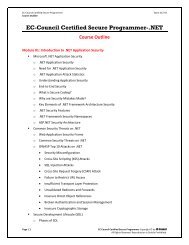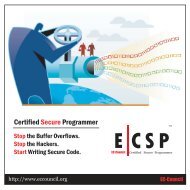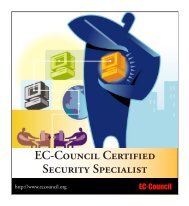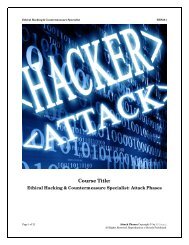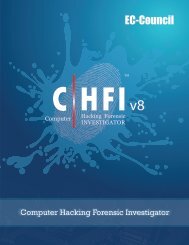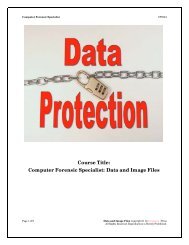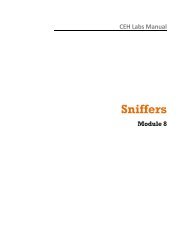CNDA Brochure - EC-Council
CNDA Brochure - EC-Council
CNDA Brochure - EC-Council
You also want an ePaper? Increase the reach of your titles
YUMPU automatically turns print PDFs into web optimized ePapers that Google loves.
<strong>EC</strong>-<strong>Council</strong>
<strong>EC</strong>-<strong>Council</strong><br />
Note: The <strong>CNDA</strong> program has been designed specially for the<br />
Government Agencies.<br />
Computers around the world are systematically being victimized by rampant<br />
hacking. This hacking is not only widespread, but is being executed so flawlessly<br />
that the attackers compromise a system, steal everything of value and completely<br />
erase their tracks within 20 minutes.<br />
The goal of the ethical hacker is to help the organization take preemptive<br />
measures against malicious attacks by attacking the system himself; all the while<br />
staying within legal limits. This philosophy stems from the proven practice of<br />
trying to catch a thief, by thinking like a thief. As technology advances and<br />
organization depend on technology increasingly, information assets have evolved<br />
into critical components of survival.<br />
If hacking involves creativity and thinking 'out-of-the-box', then vulnerability<br />
testing and security audits will not ensure the security proofing of an<br />
organization. To ensure that organizations have adequately protected their<br />
information assets, they must adopt the approach of 'defense in depth'. In other<br />
words, they must penetrate their networks and assess the security posture for<br />
vulnerabilities and exposure.<br />
The definition of an Ethical Hacker is very similar to a Penetration Tester. The<br />
Ethical Hacker is an individual who is usually employed with the organization<br />
and who can be trusted to undertake an attempt to penetrate networks and/or<br />
computer systems using the same methods as a Hacker. Hacking is a felony in the<br />
United States and most other countries. When it is done by request and under a<br />
contract between an Ethical Hacker and an organization, it is legal. The most<br />
important point is that an Ethical Hacker has authorization to probe the target.<br />
The <strong>CNDA</strong> Program certifies individuals in the specific network security<br />
discipline of Ethical Hacking from a vendor-neutral perspective. The Certified<br />
Network Defense Architect certification will fortify the application knowledge of<br />
security officers, auditors, security professionals, site administrators, and anyone<br />
who is concerned about the integrity of the network infrastructure. A Certified<br />
Network Defense Architect is a skilled professional who understands and knows<br />
http://www.eccouncil.org Page 2 of 33 Copyright 2010 <strong>EC</strong>-<strong>Council</strong>
<strong>EC</strong>-<strong>Council</strong><br />
how to look for the weaknesses and vulnerabilities in target systems and uses the<br />
same knowledge and tools as a malicious hacker.<br />
To achieve the Certified Network Defense Architect Certification, you<br />
must pass the <strong>CNDA</strong> exam 312-99:<br />
http://www.eccouncil.org Page 3 of 33 Copyright 2010 <strong>EC</strong>-<strong>Council</strong>
<strong>EC</strong>-<strong>Council</strong><br />
Course Description<br />
This class will immerse the student into an interactive environment where they<br />
will be shown how to scan, test, hack and secure their own systems. The lab<br />
intensive environment gives each student in-depth knowledge and practical<br />
experience with the current essential security systems. Students will begin by<br />
understanding how perimeter defenses work and then be lead into scanning and<br />
attacking their own networks, no real network is harmed. Students then learn<br />
how intruders escalate privileges and what steps can be taken to secure a system.<br />
Students will also learn about Intrusion Detection, Policy Creation, Social<br />
Engineering, DDoS Attacks, Buffer Overflows and Virus Creation. When a<br />
student leaves this intensive 5 day class they will have hands on understanding<br />
and experience in Ethical Hacking.<br />
This course prepares you for Certified Network Defense Architect exam 312-99<br />
Who Should Attend<br />
This course will significantly benefit security officers, auditors, security<br />
professionals, site administrators, and anyone who is concerned about the<br />
integrity of the network infrastructure. This course was specially designed for<br />
Government Agencies.<br />
Duration:<br />
5 days (9:00 – 5:00)<br />
Certification<br />
The <strong>CNDA</strong> certification exam 312-99 will be conducted on the last day of training.<br />
Students need to pass the online Prometric Prime exam to receive <strong>CNDA</strong><br />
certification.<br />
Legal Agreement<br />
<strong>CNDA</strong> course mission is to educate, introduce and demonstrate hacking tools for<br />
penetration testing purposes only. Prior to attending this course, you will be<br />
asked to sign an agreement stating that you will not use the newly acquired skills<br />
for illegal or malicious attacks and you will not use such tools in an attempt to<br />
compromise any computer system, and to indemnify <strong>EC</strong>-<strong>Council</strong> with respect to<br />
the use or misuse of these tools, regardless of intent.<br />
http://www.eccouncil.org Page 4 of 33 Copyright 2010 <strong>EC</strong>-<strong>Council</strong>
<strong>EC</strong>-<strong>Council</strong><br />
Not anyone can be a student — the Accredited Training Centers (ATC) will make<br />
sure the applicants work for legitimate companies.<br />
Course Outline Version 4<br />
Module 1: Ethics and Legality<br />
Module 2: Footprinting<br />
• Why Security<br />
• The Security, functionality and ease of use Triangle<br />
• Can Hacking be Ethical<br />
• Essential Terminology.<br />
• Elements of Security.<br />
• What does a Malicious Hacker do<br />
• Difference between Penetration Testing and Ethical Hacking.<br />
• Hacker Classes.<br />
• What do Ethical Hackers do<br />
• Skill Profile of an Ethical Hacker.<br />
• Modes of Ethical Hacking.<br />
• Security Testing.<br />
• Deliverables.<br />
• Computer Crimes and Implications.<br />
• Legal Perspective (US Federal Laws).<br />
• Defining Footprinting.<br />
• Information Gathering Methodology.<br />
• Locate the Network Range.<br />
• Hacking Tools:<br />
• Whois<br />
• Nslookup<br />
• ARIN<br />
• Traceroute<br />
• NeoTrace<br />
• VisualRoute Trace<br />
• SmartWhois<br />
• Visual Lookout<br />
http://www.eccouncil.org Page 5 of 33 Copyright 2010 <strong>EC</strong>-<strong>Council</strong>
<strong>EC</strong>-<strong>Council</strong><br />
Module 3: Scanning<br />
• VisualRoute Mail Tracker<br />
• eMailTrackerPro<br />
• Definition of Scanning.<br />
• Types of scanning<br />
• Objectives of Scanning<br />
• Scanning Methodology<br />
• Classification of Scanning<br />
• Hacking Tools<br />
• Nmap<br />
• XMAS Scan<br />
• FIN Scan<br />
• Null Scan<br />
• Windows Scan<br />
• Idle Scan<br />
• Nessus<br />
• Retina<br />
• Saint<br />
• HPing2<br />
• Firewalk<br />
• NIKTO<br />
• GFI Languard<br />
• ISS Security Scanner<br />
• Netcraft<br />
• IPsec Scan<br />
• NetScan Tools pro 2003<br />
• Super Scan<br />
• Floppyscan<br />
• War Dialer<br />
• Hacking Tools<br />
• THC Scan<br />
• Friendly Pinger<br />
• Cheops<br />
• Security Administrator’s Tool for Analyzing Network<br />
(SATAN)<br />
• SAFEsuite Internet Scanner<br />
http://www.eccouncil.org Page 6 of 33 Copyright 2010 <strong>EC</strong>-<strong>Council</strong>
<strong>EC</strong>-<strong>Council</strong><br />
Module 4: Enumeration<br />
• IdentTCPScan<br />
• PortScan Plus<br />
• Strobe<br />
• Blaster Scan<br />
• OS Fingerprinting<br />
• Active Stack fingerprinting<br />
• Tool for Active Stack fingerprinting<br />
• XPROBE2<br />
• Passive Fingerprinting<br />
• Proxy Servers<br />
• Hacking Tools<br />
• Socks Chain<br />
• Anonymizers<br />
• HTTP Tunnel<br />
• HTTPort<br />
• Countermeasures<br />
• What is Enumeration<br />
• NetBios Null Sessions<br />
• Hacking Tools<br />
• DumpSec<br />
• Winfo<br />
• NetBIOS Auditing Tool (NAT)<br />
• Null Session Countermeasures<br />
• NetBIOS Enumeration<br />
• Hacking Tool :NBTScan<br />
• Simple Network Management Protocol (SNMP)<br />
Enumeration<br />
• Hacking Tools<br />
• Solarwinds<br />
• Enum<br />
• SNScan<br />
• SNMP Enumeration Countermeasures<br />
• Management Information Base (MIB)<br />
• Windows 2000 DNS Zone Transfer<br />
• Blocking Win 2k DNS Zone Transfer<br />
http://www.eccouncil.org Page 7 of 33 Copyright 2010 <strong>EC</strong>-<strong>Council</strong>
Module 5: System Hacking<br />
<strong>EC</strong>-<strong>Council</strong><br />
• Enumerating User Accounts<br />
• Hacking Tools<br />
• User2sid and Sid2user<br />
• UserInfo<br />
• GetAcct<br />
• DumpReg<br />
• Trout<br />
• Winfingerprint<br />
• PsTools<br />
(PSFile,PSLoggedOn,PSGetSid,PSInfo,PSService,P<br />
SList,PSKill,<br />
• PSSuspend, PSLogList, PSExec, PSShutdown)<br />
• Active Directory Enumeration and Countermeasures<br />
• Administrator Password Guessing<br />
• Manual Password Cracking Algorithm<br />
• Automated Password Cracking<br />
• Password Types<br />
• Types of Password Attacks<br />
• Hacking Tool<br />
• NTInfoScan (CIS)<br />
• Performing Automated Password Guessing<br />
• Hacking Tool<br />
• Legion<br />
• Password Sniffing<br />
• Hacking Tools<br />
• LOphtcrack<br />
• pwdump2 and pwdump3<br />
• KerbCrack<br />
• NBTdeputy<br />
• NetBIOS DoS Attack<br />
• Hacking Tools<br />
• NBName<br />
• John the Ripper<br />
• LAN Manager Hash<br />
• Password Cracking Countermeasures<br />
http://www.eccouncil.org Page 8 of 33 Copyright 2010 <strong>EC</strong>-<strong>Council</strong>
• Syskey Utility<br />
• Cracking NT/2000 Passwords<br />
• Hacking Tool<br />
• NTFSDOS<br />
• SMB Logon<br />
• Hacking Tool: SMBRelay<br />
• SMBRelay Man-in-the-Middle Scenario<br />
• Hacking Tool : SMBRelay2<br />
• SMBRelay Weaknesses and Countermeasures<br />
• Hacking Tools<br />
• SMBGrind<br />
• SMBDie<br />
• Privilege Escalation<br />
• Hacking Tools<br />
• GetAdmin<br />
• hk.exe<br />
• Keystroke Loggers<br />
• Hacking Tools<br />
• IKS Software Keylogger<br />
• Ghost Keylogger<br />
• Hardware Key Logger<br />
• Spyware Spector<br />
• eBlaster<br />
• Hiding Files<br />
• Creating Alternate Data Streams<br />
• ADS creation and detection<br />
• Hacking Tools<br />
• Makestream<br />
• ads_cat<br />
• Streams<br />
• LADS (List Alternate Data Streams)<br />
• NTFS Streams Countermeasures<br />
• Stealing Files Using Word Documents<br />
• Field Code Countermeasures<br />
• Steganography<br />
• Spyware Tool - Desktop Spy<br />
• Hacking Tools<br />
• Steganography tools<br />
<strong>EC</strong>-<strong>Council</strong><br />
http://www.eccouncil.org Page 9 of 33 Copyright 2010 <strong>EC</strong>-<strong>Council</strong>
<strong>EC</strong>-<strong>Council</strong><br />
• DiSi-Steganograph<br />
• EZStego<br />
• Gif-It-Up v1.0<br />
• Gifshuffle<br />
• Hide and Seek<br />
• JPEG-JSTEG<br />
• MandelSteg and GIFExtract<br />
• Mp3Stego<br />
• Nicetext<br />
• Pretty Good Envelope<br />
• OutGuess<br />
• SecurEngine<br />
• Stealth<br />
• Snow<br />
• Steganography Tools 4<br />
• Steganos<br />
• Steghide<br />
• Stegodos<br />
• Stegonosaurus<br />
• StegonoWav<br />
• wbStego<br />
• Image Hide<br />
• MP3Stego<br />
• StegonoWav<br />
• Snow.exe<br />
• Camera/Shy<br />
• Steganography Detection<br />
• Hacking Tool<br />
• diskprobe.exe<br />
• Covering Tracks<br />
• Disabling Auditing and clearing Event Logs<br />
• Hacking Tool<br />
• Dump Event Log<br />
• elsave.exe<br />
• WinZapper<br />
• Evidence Eliminator<br />
• RootKit<br />
• Planting the NT/2000 RootKit<br />
http://www.eccouncil.org Page 10 of 33 Copyright 2010 <strong>EC</strong>-<strong>Council</strong>
<strong>EC</strong>-<strong>Council</strong><br />
• Hacking Tools<br />
• Fu<br />
• Vanquish<br />
• Rootkit Countermeasures<br />
• Hacking Tool<br />
• Patchfinder 2.0<br />
Module 6: Trojans and Backdoors<br />
• Effect on Business<br />
• What is a Trojan<br />
• Overt and Covert Channels<br />
• Working of Trojans<br />
• Different Types of Trojans<br />
• What Trojan Creators look for<br />
• Different ways a Trojan can get into a system<br />
• Indications of a Trojan Attack<br />
• Some famous Trojans and ports used by them<br />
• How to determine which ports are “Listening”<br />
• Different Trojans found in the Wild<br />
• Beast 2.06<br />
• Phatbot<br />
• Senna Spy<br />
• CyberSpy<br />
• Remote Encrypted Callback UNIX Backdoor (R<strong>EC</strong>UB)<br />
• Amitis<br />
• QAZ<br />
• Back Orifice<br />
• Back Orifice 2000<br />
• Tini<br />
• NetBus<br />
• SubSeven<br />
• Netcat<br />
• Subroot<br />
• Let me Rule 2.0 Beta 9<br />
• Donald Dick<br />
• Graffiti.exe<br />
• EliteWrap<br />
http://www.eccouncil.org Page 11 of 33 Copyright 2010 <strong>EC</strong>-<strong>Council</strong>
Module 7: Sniffers<br />
<strong>EC</strong>-<strong>Council</strong><br />
• IconPlus<br />
• Restorator<br />
• Whack-a-mole<br />
• Firekiller 2000<br />
• BoSniffer<br />
• Wrappers<br />
• Packaging Tool : Wordpad<br />
• Hard Disk Killer (HDKP 4.0)<br />
• ICMP Tunneling<br />
• Hacking Tool: Loki<br />
• Loki Countermeasures<br />
• Reverse WWW Shell – Covert Channels using HTTP<br />
• Hacking Tools<br />
• fPort<br />
• TCP View<br />
• Tripwire<br />
• Process Viewer<br />
• Inzider-Tracks Processes and Ports<br />
• System File Verification<br />
• Trojan horse Construction Kit<br />
• Anti-Trojan<br />
• Evading Anti-Trojan/Anti-Virus using Stealth Tools v 2.0<br />
• Reverse Engineering Trojans<br />
• Backdoor Countermeasures<br />
• Definition of sniffing<br />
• How a Sniffer works<br />
• Passive Sniffing<br />
• Active Sniffing<br />
• Hacking Tool: EtherFlood<br />
• Man-in-the-Midle Attacks<br />
• Spoofing and Sniffing Attacks<br />
• ARP Poisoning and countermeasures<br />
• Hacking Tools<br />
• Ethereal<br />
• Dsniff<br />
http://www.eccouncil.org Page 12 of 33 Copyright 2010 <strong>EC</strong>-<strong>Council</strong>
<strong>EC</strong>-<strong>Council</strong><br />
Module 8: Denial of Service<br />
• Sniffit<br />
• Aldebaran<br />
• Hunt<br />
• NGSSniff<br />
• Ntop<br />
• pf<br />
• IPTraf<br />
• Etherape<br />
• Netfilter<br />
• Network Probe<br />
• Maa Tec Network Analyzer<br />
• Snort<br />
• Macof, MailSnarf, URLSnarf, WebSpy<br />
• Windump<br />
• Etherpeek<br />
• Ettercap<br />
• SMAC<br />
• Mac Changer<br />
• Iris<br />
• NetIntercept<br />
• WinDNSSpoof<br />
• NetIntercept<br />
• Win DNSpoof<br />
• TCPDump<br />
• Network Monitor<br />
• Gobbler<br />
• ETHLOAD<br />
• Esniff<br />
• Sunsniff<br />
• Linux_sniffer<br />
• Sniffer Pro<br />
• Sniffing Countermeasures<br />
• What is Denial of Service<br />
• Goal of DoS(Denial of Service)<br />
• Impact and Modes of Attack<br />
http://www.eccouncil.org Page 13 of 33 Copyright 2010 <strong>EC</strong>-<strong>Council</strong>
<strong>EC</strong>-<strong>Council</strong><br />
• DoS Attack Classification<br />
• Smurf<br />
• Buffer Overflow Attacks<br />
• Ping Of death<br />
• Teardrop<br />
• SYN<br />
• Tribal Flow Attack<br />
• Hacking Tools<br />
• Jolt2<br />
• Bubonic.c<br />
• Land and LaTierra<br />
• Targa<br />
• Distributed DOS Attacks and Characteristics<br />
• Agent Handler Model<br />
• IRC-Based DDoS Attack Model<br />
• DDoS Attack taxonomy<br />
• DDoS Tools<br />
• Trin00<br />
• Tribe Flow Network (TFN)<br />
• TFN2K<br />
• Stacheldraht<br />
• Shaft<br />
• Trinity<br />
• Knight<br />
• Mstream<br />
• Kaiten<br />
• Reflected DOS Attacks<br />
• Reflection of the Exploit<br />
• Countermeasures for Reflected DoS<br />
• Tools for Detecting DDOS Attacks<br />
• ipgrep<br />
• tcpdstat<br />
• findoffer<br />
• DDoS Countermeasures<br />
• Defensive Tool: Zombie Zapper<br />
• Worms: Slammer and MyDoom.B<br />
http://www.eccouncil.org Page 14 of 33 Copyright 2010 <strong>EC</strong>-<strong>Council</strong>
<strong>EC</strong>-<strong>Council</strong><br />
Module 9: Social Engineering<br />
Module10: Session Hijacking<br />
• What is Social Engineering<br />
• Art of Manipulation<br />
• Human Weakness<br />
• Common Types of Social Engineering<br />
• Human Based Impersonation<br />
• Example of social engineering<br />
• Computer Based Social Engineering<br />
• Reverse Social Engineering<br />
• Policies and procedures<br />
• Security Policies-checklist<br />
• Understanding Session Hijacking<br />
• Spoofing vs Hijacking<br />
• Steps in Session Hijacking<br />
• Types of Session Hijacking<br />
• TCP Concepts 3 Way Handshake<br />
• Sequence numbers<br />
• Hacking Tools<br />
• Juggernaut<br />
• T-Sight<br />
• TTY Watcher<br />
• IP Watcher<br />
• Hunt<br />
• Paros v3.1.1<br />
• TTY-Watcher<br />
• IP Watcher<br />
• T-sight<br />
• Remote TCP Session Reset Utility<br />
• Dangers Posed by Session Hijacking<br />
• Protection against Session Hijacking<br />
• Countermeasures: IP Security<br />
Module 11: Hacking Web Servers<br />
http://www.eccouncil.org Page 15 of 33 Copyright 2010 <strong>EC</strong>-<strong>Council</strong>
<strong>EC</strong>-<strong>Council</strong><br />
• How Web Servers Work<br />
• How are Web Servers Compromised<br />
• Popular Web Servers and Common Security Threats<br />
• Apache Vulnerability<br />
• Attack against IIS<br />
• IIS Components<br />
• Sample Buffer Overflow Vulnerabilities<br />
• Hacking Tool: IISHack.exe<br />
• ISAPI.DLL Exploit<br />
• Code Red and ISAPI.DLL Exploit<br />
• Unicode<br />
• Unicode Directory Traversal Vulnerability<br />
• Hacking Tools<br />
• Unicodeuploader.pl<br />
• IISxploit.exe<br />
• execiis-win32.exe<br />
• Msw 3prt IPP Vulnerability<br />
• Hacking Tool: Jill.c<br />
• IPP Buffer Overflow Countermeasures<br />
• Unspecified Executed Path Vulnerability<br />
• File System Traversal Countermeasures<br />
• WebDAV/ ntdll.dll Vulnerability<br />
• Real World instance of WebDAV Exploit<br />
• Hacking Tool: “KaHT”<br />
• RPCDCOM Vulnerability<br />
• ASN Exploits<br />
• IIS Logs<br />
• Network Tool: Log Analyzer<br />
• Hacking Tool: Clean IISLog<br />
• Escalating Privileges on IIS<br />
• Hacking Tools<br />
• hk.exe<br />
• cmdasp.asp<br />
• iiscrack.dll<br />
• ispc.exe<br />
• Microsoft IIS 5.0 - 5.1 remote denial of service Exploit Tool<br />
• Microsoft Frontpage Server Extensions fp30reg.dll Exploit<br />
Tool<br />
http://www.eccouncil.org Page 16 of 33 Copyright 2010 <strong>EC</strong>-<strong>Council</strong>
<strong>EC</strong>-<strong>Council</strong><br />
• GDI+ JPEG Remote Exploit Tool<br />
• Windows Task Scheduler Exploit Tool<br />
• Microsoft Windows POSIX Subsystem Local Privilege<br />
Escalation Exploit Tool<br />
• Hot Fixes and Patches<br />
• Solution: UpdateEXPERT<br />
• cacls.exe Utility<br />
• Vulnerability Scanners<br />
• Network Tools<br />
• Whisker<br />
• N-Stealth<br />
• Webinspect<br />
• Shadow Security Scanner<br />
• Countermeasures<br />
• Increasing Web Server Security<br />
Module 12: Web Application Vulnerabilities<br />
• Web Application Set-up<br />
• Web Application Hacking<br />
• Anatomy of an Attack<br />
• Web Application Threats<br />
• Cross Site Scripting/XSS Flaws<br />
• An Example of XSS<br />
• Countermeasures<br />
• SQL Injection<br />
• Command Injection Flaws<br />
• Countermeasures<br />
• Cookie/Session Poisoning<br />
• Countermeasures<br />
• Parameter/Form Tampering<br />
• Buffer Overflow<br />
• Countermeasures<br />
• Directory Traversal/Forceful Browsing<br />
• Countermeasures<br />
• Cryptographic Interception<br />
• Authentication Hijacking<br />
• Countermeasures<br />
http://www.eccouncil.org Page 17 of 33 Copyright 2010 <strong>EC</strong>-<strong>Council</strong>
• Log Tampering<br />
• Error Message Interception<br />
• Attack Obfuscation<br />
• Platform Exploits<br />
• Internet Explorer Exploits<br />
• DMZ Protocol Attacks<br />
• DMZ<br />
• Countermeasures<br />
• Security Management Exploits<br />
• Web Services Attacks<br />
• Zero Day Attacks<br />
• Network Access Attacks<br />
• TCP Fragmentation<br />
• Hacking Tools:<br />
• Instant Source<br />
• Wget<br />
• WebSleuth<br />
• Black Widow<br />
• Window Bomb<br />
• Burp: Positioning Payloads<br />
• Burp: Configuring Payloads and Content Enumeration<br />
• Burp<br />
• Burp Proxy: Intercepting HTTP/S Traffic<br />
• Burp Proxy: Hex-editing of Intercepted Traffic<br />
• Burp Proxy: Browser Access to Request History<br />
• Hacking Tool: cURL<br />
• Carnivore<br />
• Google Hacking<br />
Module 13: Web Based Password Cracking Techniques<br />
• Authentication- Definition<br />
• Authentication Mechanisms<br />
• HTTP Authentication<br />
• Basic Authentication<br />
• Digest Authentication<br />
• Integrated Windows (NTLM) Authentication<br />
• Negotiate Authentication<br />
<strong>EC</strong>-<strong>Council</strong><br />
http://www.eccouncil.org Page 18 of 33 Copyright 2010 <strong>EC</strong>-<strong>Council</strong>
Module 14: SQL Injection<br />
<strong>EC</strong>-<strong>Council</strong><br />
• Certificate-based Authentication<br />
• Forms-based Authentication<br />
• Microsoft Passport Authentication<br />
• What is a Password Cracker<br />
• Modus Operandi of an Attacker using Password Cracker<br />
• How does a Password Cracker work<br />
• Attacks- Classification<br />
• Password Guessing<br />
• Query String<br />
• Cookies<br />
• Dictionary Maker<br />
• Password Crackers Available<br />
• LOphtcrack<br />
• John The Ripper<br />
• Brutus<br />
• Obiwan<br />
• Authforce<br />
• Hydra<br />
• Cain and Abel<br />
• RAR<br />
• Gammaprog<br />
• Hacking Tools:<br />
• WebCracker<br />
• Munga Bunga<br />
• PassList<br />
• Read Cookies<br />
• SnadBoy<br />
• WinSSLMiM<br />
• “Mary had a Little Lamb” Formula<br />
• Countermeasures<br />
• Attacking SQL Servers<br />
• SQL Server Resolution Service (SSRS)<br />
• Osql-L Probing<br />
• Port Scanning<br />
http://www.eccouncil.org Page 19 of 33 Copyright 2010 <strong>EC</strong>-<strong>Council</strong>
• Sniffing, Brute Forcing and finding Application<br />
Configuration Files<br />
• Tools for SQL Server Penetration Testing<br />
• SQLDict<br />
• SqlExec<br />
• SQLbf<br />
• SQLSmack<br />
• SQL2.exe<br />
• AppDetective<br />
• Database Scanner<br />
• SQLPoke<br />
• NGSSQLCrack<br />
• NGSSQuirreL<br />
• SQLPing v2.2<br />
• OLE DB Errors<br />
• Input Validation Attack<br />
• Login Guessing & Insertion<br />
• Shutting Down SQL Server<br />
• Extended Stored Procedures<br />
• SQL Server Talks<br />
• Preventive Measures<br />
Module 15: Hacking Wireless Networks<br />
• Introduction to Wireless Networking<br />
• Business and Wireless Attacks<br />
• Wireless Basics<br />
• Components of Wireless Network<br />
• Types of Wireless Network<br />
• Setting up WLAN<br />
• Detecting a Wireless Network<br />
• How to access a WLAN<br />
• Advantages and Disadvantages of Wireless Network<br />
• Antennas<br />
• SSIDs<br />
• Access Point Positioning<br />
• Rogue Access Points<br />
• Tools to Generate Rogue Access Points<br />
<strong>EC</strong>-<strong>Council</strong><br />
http://www.eccouncil.org Page 20 of 33 Copyright 2010 <strong>EC</strong>-<strong>Council</strong>
<strong>EC</strong>-<strong>Council</strong><br />
• Fake AP<br />
• NetStumbler<br />
• MiniStumbler<br />
• What is Wireless Equivalent Privacy (WEP)<br />
• WEP Tool:<br />
• AirSnort<br />
• WEPCrack<br />
• Related Technology and Carrier Networks<br />
• MAC Sniffing and AP Spoofing<br />
• Tool to detect MAC Address Spoofing: Wellenreiter v2<br />
• Terminology<br />
• Denial of Service Attacks<br />
• DoS Attack Tool: FATAjack<br />
• Man-in-the-Middle Attack (MITM)<br />
• Scanning Tools:<br />
• Redfang<br />
• Kismet<br />
• THC- WarDrive v2.1<br />
• PrismStumbler<br />
• MacStumbler<br />
• Mognet v1.16<br />
• WaveStumbler<br />
• StumbVerter v1.5<br />
• NetChaser v1.0 for Palm tops<br />
• AP Scanner<br />
• Wavemon<br />
• Wireless Security Auditor (WSA)<br />
• AirTraf 1.0<br />
• Wifi Finder<br />
• Sniffing Tools:<br />
• AiroPeek<br />
• NAI Sniffer Wireless<br />
• Ethereal<br />
• Aerosol v0.65<br />
• vxSniffer<br />
• EtherPEG<br />
• Drifnet<br />
• AirMagnet<br />
http://www.eccouncil.org Page 21 of 33 Copyright 2010 <strong>EC</strong>-<strong>Council</strong>
Module 16 : Virus and Worms<br />
• WinDump 3.8 Alpha<br />
• ssidsniff<br />
• Multi Use Tool: THC-RUT<br />
• Tool: WinPcap<br />
• Auditing Tool: bsd-airtools<br />
• WIDZ- Wireless Detection Intrusion System<br />
• Securing Wireless Networks<br />
• Out of the box Security<br />
• Radius: Used as Additional layer in security<br />
• Maximum Security: Add VPN to Wireless LAN<br />
• Virus Characteristics<br />
• Symptoms of ‘virus-like’ attack<br />
• What is a Virus Hoax<br />
• Terminologies<br />
• How is a worm different from virus<br />
• Indications of a Virus Attack<br />
• Virus History<br />
• Virus damage<br />
• Effect of Virus on Business<br />
• Access Methods of a Virus<br />
• Mode of Virus Infection<br />
• Life Cycle of a virus<br />
• What Virus Infect<br />
• How virus infect<br />
• Virus/worm found in the wild:<br />
• W32.CIH.Spacefiller (a.k.a Chernobyl)<br />
• Win32/Explore.Zip Virus<br />
• I Love You Virus<br />
• Melissa Virus<br />
• Pretty Park<br />
• Code red Worm<br />
• W32/Klez<br />
• Bug Bear<br />
• SirCam Worm<br />
• Nimda<br />
<strong>EC</strong>-<strong>Council</strong><br />
http://www.eccouncil.org Page 22 of 33 Copyright 2010 <strong>EC</strong>-<strong>Council</strong>
<strong>EC</strong>-<strong>Council</strong><br />
Module 17: Physical Security<br />
• SQL Slammer<br />
• Writing a simple virus program.<br />
• Writing DDOS Zombie Virus<br />
• Virus Construction Kits<br />
• Virus Creation Scripts<br />
• Virus Detection Methods<br />
• Virus Incident Response<br />
• What is Sheep Dip<br />
• Prevention is better than Cure<br />
• Anti-Virus Software<br />
• Popular Anti-Virus packages<br />
• New Virus found in 2004<br />
• Virus Checkers<br />
• Blaster – Virus Analysis<br />
• Nimda – Virus Analysis<br />
• Sasser Worm – Virus Analysis<br />
• Klez – Virus Analysis<br />
• IDAPro<br />
• Virus Analyzers<br />
• Security statistics<br />
• Physical Security breach incidents<br />
• Understanding Physical Security<br />
• What is the need of Physical Security<br />
• Who is Accountable for Physical Security<br />
• Factors affecting Physical Security<br />
• Physical Security checklist<br />
• Company surroundings<br />
• Premises<br />
• Reception<br />
• Server<br />
• Workstation Area<br />
• Wireless Access Points<br />
• Other Equipments such as fax, removable media etc<br />
• Access Control<br />
• Computer Equipment Maintenance<br />
http://www.eccouncil.org Page 23 of 33 Copyright 2010 <strong>EC</strong>-<strong>Council</strong>
<strong>EC</strong>-<strong>Council</strong><br />
Module 18: Linux Hacking<br />
• Wiretapping<br />
• Remote access<br />
• Lock Picking Techniques<br />
• Spying Technologies<br />
• Why Linux<br />
• Linux basics<br />
• Chrooting<br />
• Why is Linux Hacked<br />
• Linux Vulnerabilities in 2003<br />
• How to apply patches to vulnerable programs<br />
• Scanning Networks<br />
• Scanning Tool: Nessus<br />
• Cheops<br />
• Port Scan detection tools:<br />
• Klaxon<br />
• Scanlogd<br />
• PortSentry<br />
• LIDS (Linux Intrusion Detection System)<br />
• Password cracking in Linux.<br />
• Password cracking tools:<br />
• John the Ripper<br />
• Viper<br />
• Slurpie<br />
• IPChains<br />
• IPTables<br />
• ipchains vs. ipfwadm<br />
• How to Organize Firewall Rules<br />
• Security Auditor’s Research Assistant (SARA)<br />
• Hacking Tool:<br />
• Sniffit<br />
• HPing2<br />
• Hunt<br />
• TCP Wrappers<br />
• Linux Loadable Kernel Modules<br />
• Linux Rootkits:<br />
http://www.eccouncil.org Page 24 of 33 Copyright 2010 <strong>EC</strong>-<strong>Council</strong>
• Knark<br />
• Torn<br />
• Tuxit<br />
• Adore<br />
• Ramen<br />
• Beast<br />
• Rootkit countermeasures:<br />
• Chkrootki<br />
• Tripwire<br />
• Bastille Linux<br />
• LIDS(Linux Intrusion Detection system)<br />
• Dtk<br />
• Rkdet<br />
• Rootkit Hunter<br />
• Carbonite<br />
• Rscan<br />
• Saint Jude<br />
• Linux Security Tools:<br />
• Whisker<br />
• Flawfinder<br />
• Advanced Intrusion Detection System (AIDE)<br />
• Linux Security testing tools<br />
• NMap<br />
• LSOF<br />
• Netcat<br />
• Nemesis<br />
• Linux Encryption Tools:<br />
• Stunnel<br />
• OpenSSH/SSH<br />
• SSH<br />
• GnuPG<br />
• Linux tools: Log and traffic monitors:<br />
• MRTG<br />
• Swatch<br />
• Timbersee<br />
• Logsurf<br />
• IPLog<br />
• IPTraf<br />
<strong>EC</strong>-<strong>Council</strong><br />
http://www.eccouncil.org Page 25 of 33 Copyright 2010 <strong>EC</strong>-<strong>Council</strong>
<strong>EC</strong>-<strong>Council</strong><br />
• Ntop<br />
• Linux Security Auditing Tool (LSAT)<br />
• Linux Security countermeasures<br />
Module 19: Evading Firewalls, IDS and Honeypots<br />
• Intrusion Detection Systems<br />
• Ways to Detect Intrusion<br />
• Types of Intrusion Detection System<br />
• Intrusion Detection Tools<br />
o Snort 2.1.0<br />
o Symantec ManHunt<br />
o LogIDS 1.0<br />
o SnoopNetCop Standard<br />
o Prelude Hybrid IDS version 0.8.x<br />
o Samhain<br />
• Steps to perform after an IDS detects an intrusion<br />
• Evading IDS systems<br />
• Tools to Evade IDS<br />
o SideStep<br />
o ADMutate<br />
o Mendax v.0.7.1<br />
o Stick<br />
o Fragrouter<br />
o Anzen NIDSbench<br />
• Packet Generators<br />
• Introduction to Firewalls<br />
• Firewall Identification<br />
• Firewalking<br />
• Banner Grabbing<br />
• Breaching Firewalls<br />
• Placing Backdoors through Firewalls<br />
• Hiding Behind Covert Channel: Loki<br />
• ACK tunneling<br />
• Tools to Breach Firewall<br />
o 007 Shell<br />
o ICMP Shell<br />
o AckCmd<br />
http://www.eccouncil.org Page 26 of 33 Copyright 2010 <strong>EC</strong>-<strong>Council</strong>
<strong>EC</strong>-<strong>Council</strong><br />
o Covert TCP1.0<br />
• Tools for testing IDS and Firewalls<br />
• Introduction to Honeypots<br />
• Honeypot Project<br />
• Types of Honeypots<br />
• Honeypot: Specter<br />
• Honeypot: Honeyd<br />
• Honeypot: KFSensor<br />
• Hacking Tool: Sebek<br />
• Tools to Detect Honeypot<br />
o Send-Safe Honeypot Hunter<br />
o Nessus Security Scanner<br />
Module 20 : Buffer Overflows<br />
Module 21 : Cryptography<br />
• Significance of Buffer Overflow Vulnerability<br />
• Why are Programs/Applications Vulnerable<br />
• Buffer Overflows<br />
• Reasons for Buffer Overflow Attacks<br />
• Knowledge required writing Buffer Overflow Exploits<br />
• How a Buffer Overflow occurs<br />
• Understanding Stacks<br />
• Stack Implementation<br />
• Stack based buffer overflow<br />
• Shellcode<br />
• Heap Based buffer overflow<br />
• How to detect Buffer Overflows in a Program<br />
• Attacking a real program<br />
• NOPS<br />
• How to mutate a Buffer Overflow Exploit featuring<br />
ADMutate<br />
• Countermeasures<br />
• Return Address Defender (RAD)<br />
• StackGuard<br />
• Immunix System<br />
• Vulnerability Search - ICAT<br />
http://www.eccouncil.org Page 27 of 33 Copyright 2010 <strong>EC</strong>-<strong>Council</strong>
• Public-key Cryptography<br />
• Working of Encryption<br />
• Digital Signature<br />
• Digital Certificate<br />
• RSA (Rivest Shamir Adleman)<br />
• RSA Attacks<br />
• Brute forcing RSA factoring<br />
• Esoteric attack<br />
• Chosen cipher text attack<br />
• Low encryption exponent attack<br />
• Error analysis<br />
• Other attacks<br />
• MD5<br />
• SHA (Secure Hash Algorithm)<br />
• SSL (Secure Socket Layer)<br />
• RC5<br />
• What is SSH<br />
• Government Access to Keys (GAK)<br />
• RSA Challenge<br />
• distributed.net<br />
• PGP (Pretty Good Privacy)<br />
• Code Breaking Methodologies<br />
• Using Brute Force<br />
• Frequency Analysis<br />
• Trickery and Deceit<br />
• One-Time Pad<br />
• Cryptography Attacks<br />
• Disk Encryption<br />
• PGPCrack<br />
• Magic Lantern<br />
• WEPCrack<br />
• Cracking S/MIME Encryption using idle CPU Time<br />
• CypherCalc<br />
• Command Line Scriptor<br />
• CryptoHeaven<br />
<strong>EC</strong>-<strong>Council</strong><br />
http://www.eccouncil.org Page 28 of 33 Copyright 2010 <strong>EC</strong>-<strong>Council</strong>
<strong>EC</strong>-<strong>Council</strong><br />
Module 22 : Penetration Testing<br />
• Need for a Methodology<br />
• Penetration Test vs. Vulnerability Test<br />
• Reliance on Checklists and Templates<br />
• Phases of Penetration Testing<br />
• Passive Reconnaissance<br />
• Best Practices<br />
• Results that can be expected<br />
• Indicative passive reconnaissance steps include (but are<br />
not limited to)<br />
• Introduction to Penetration Testing<br />
• Type of Penetration Testing Methodologies<br />
• Open Source Vs Proprietary Methodologies<br />
• Security Assessment Vs Security Auditing<br />
• Risk Analysis<br />
• Types of Penetration Testing<br />
• Types Ethical Hacking<br />
• Vulnerability Assessment Vs Penetration Testing<br />
• Do-it Yourself Testing<br />
• Firms Offering Penetration Testing Services<br />
• Penetration Testing Insurance<br />
• Explication of Terms of Engagement<br />
• Pen-Test Service Level Agreements<br />
• Offer of Compensation<br />
• Starting Point and Ending Points of Testing<br />
• Penetration Testing Locations<br />
• Black Box Testing<br />
• White Box Testing<br />
• Grey Box Testing<br />
• Manual Penetration Testing<br />
• Automated Penetration Testing<br />
• Selecting the Right Tools<br />
• Pen Test Using Appscan<br />
• HackerShield<br />
• Pen-Test Using Cerberus Internet Scanner<br />
• Pen-Test Using CyberCop Scanner<br />
• Pen-Test Using Foundscan<br />
http://www.eccouncil.org Page 29 of 33 Copyright 2010 <strong>EC</strong>-<strong>Council</strong>
<strong>EC</strong>-<strong>Council</strong><br />
• Pen-Test Using Nessus<br />
• Pen-Test Using NetRecon<br />
• Pen-Test Using Retina<br />
• Pen-Test Using SAINT<br />
• Pen-Test Using SecureNET<br />
• Pen-Test Using SecureScan<br />
• Pen-Test Using SATAN, SARA and Security Analyzer<br />
• Pen-Test Using STAT Analyzer<br />
• Pen-Test Using Twwscan<br />
• VigilEnt<br />
• WebInspect<br />
• Evaluating Different Types of Pen-Test Tools<br />
• Platform on Which Tools Will be Used<br />
• Asset Audit<br />
• Fault Tree and Attack Trees<br />
• GAP Analysis<br />
• Device Inventory<br />
• Perimeter Firewall Inventory<br />
• Web Server Inventory<br />
• Load Balancer Inventory<br />
• Local Area Network Inventory<br />
• Demilitarized Zone Firewall<br />
• Internal Switch Network Sniffer<br />
• Application Server Inventory<br />
• Database Server Inventory<br />
• Name Controller and Domain Name Server<br />
• Physical Security<br />
• ISP Routers<br />
• Legitimate Network Traffic Threat<br />
• Unauthorized Network Traffic Threat<br />
• Unauthorized Running Process Threat<br />
• Loss of Confidential Information<br />
• Business Impact of Threat<br />
• Pre-testing Dependencies<br />
• Post-testing Dependencies<br />
• Failure Management<br />
• Test Documentation Processes<br />
• Penetration Testing Tools<br />
http://www.eccouncil.org Page 30 of 33 Copyright 2010 <strong>EC</strong>-<strong>Council</strong>
<strong>EC</strong>-<strong>Council</strong><br />
• Defect Tracking Tools<br />
• Configuration Management Tools<br />
• Disk Replication Tools<br />
• Pen-Test Project Scheduling Tools<br />
• Network Auditing Tools<br />
• DNS Zone Transfer Testing Tools<br />
• Trace Route Tools and Services<br />
• Network Sniffing Tools<br />
• Denial of Service Emulation Tools<br />
• Traditional Load Testing Tools<br />
• System Software Assessment Tools<br />
• Operating System Protection Tools<br />
• Fingerprinting Tools<br />
• Port Scanning Tools<br />
• Directory and File Access Control Tools<br />
• File Share Scanning Tools<br />
• Password Directories<br />
• Password Guessing Tools<br />
• Link Checking Tools<br />
• Web site Crawlers<br />
• Web-Testing based Scripting Tools<br />
• Buffer Overflow Protection Tools<br />
• Buffer Overflow Generation Tools<br />
• Input Data Validation Tools<br />
• File encryption Tools<br />
• Database Assessment Tools<br />
• Keyboard Logging and Screen Reordering Tools<br />
• System Event Logging and Reviewing Tools<br />
• Tripwire and Checksum Tools<br />
• Mobile-Code Scanning Tools<br />
• Centralized Security Monitoring Tools<br />
• Web Log Analysis Tools<br />
• Forensic Data and Collection Tools<br />
• Security Assessment Tools<br />
• Multiple OS Management Tools<br />
• SANS Institute TOP 20 Security Vulnerabilities<br />
• All Operating System Platforms<br />
http://www.eccouncil.org Page 31 of 33 Copyright 2010 <strong>EC</strong>-<strong>Council</strong>
<strong>EC</strong>-<strong>Council</strong><br />
• Default installs of operating systems and<br />
applications<br />
• Accounts with no passwords or weak<br />
passwords<br />
• Nonexistent or incomplete backups<br />
• Large number of open ports<br />
• Not filtering packets for correct incoming<br />
and outgoing addresses<br />
• Nonexistent or incomplete logging<br />
• Vulnerable Common Gateway Interface<br />
(CGI) programs<br />
• Windows-specific<br />
• Unicode vulnerability-Web server folder<br />
traversal<br />
• Internet server application programming<br />
interface (ISAPI) extension buffer<br />
overflows<br />
• IIS Remote Data Services (RDS) exploit<br />
• Network Basic Input Output System<br />
(NetBIOS), unprotected Windows<br />
networking shares<br />
• Information leakage via null session<br />
connections<br />
• Weak hashing in SAM (Security Accounts<br />
Manager)-LanManager hash<br />
• UNIX-specific<br />
• Buffer overflows in Remote Procedure<br />
Call (RPC) services<br />
• Sendmail vulnerabilities<br />
• Bind weaknesses<br />
• Remote system command (such as rcp,<br />
rlogin, and rsh) vulnerabilities<br />
• Line Printer Daemons (LPD)<br />
vulnerabilities<br />
• Sadmind and mountd exploits<br />
• Default Simple Network Management<br />
Protocol (SNMP) strings<br />
• Penetration Testing Deliverable Templates<br />
http://www.eccouncil.org Page 32 of 33 Copyright 2010 <strong>EC</strong>-<strong>Council</strong>
<strong>EC</strong>-<strong>Council</strong><br />
• Test Status Report Identifier<br />
• Test Variances<br />
• Test Comprehensive Assessment<br />
• Summary of Results (Incidents)<br />
• Test Evaluation<br />
• Names of Persons (Approval)<br />
• Template Test Incident Report<br />
• Template Test Log<br />
• Active Reconnaissance<br />
• Attack Phase<br />
• Activity: Perimeter Testing<br />
• Activity: Web Application Testing – I<br />
• Activity: Web Application Testing – II<br />
• Activity: Wireless Testing<br />
• Activity: Acquiring Target<br />
• Activity: Escalating Privileges<br />
• Activity: Execute, Implant & Retract<br />
• Post Attack Phase & Activities<br />
• Automated Penetration Testing Tool - CORE Impact<br />
© 2010 <strong>EC</strong>-<strong>Council</strong>. All rights reserved.<br />
This document is for informational purposes only. <strong>EC</strong>-<strong>Council</strong> MAKES NO<br />
WARRANTIES, EXPRESS OR IMPLIED, IN THIS SUMMARY. <strong>EC</strong>-<strong>Council</strong> logo<br />
is registered trademarks or trademarks of <strong>EC</strong>-<strong>Council</strong> in the United States and/or<br />
other countries.<br />
End of Document<br />
http://www.eccouncil.org Page 33 of 33 Copyright 2010 <strong>EC</strong>-<strong>Council</strong>



